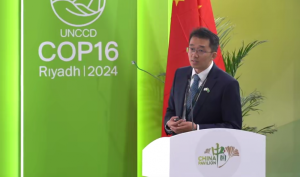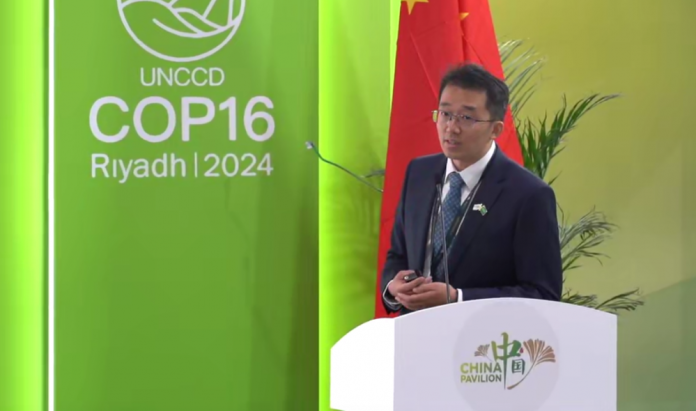[International Energy Network Live Report] The China Pavilion held a side event with the theme of “Planning and Ecological Design of Solar PV Power Stations in Desert Areas” on the morning of December 10th, in Riyadh, Saudi Arabia. The conference was hosted by the The Research Center for Energy Transition and Social Development, School of Social Sciences, Tsinghua University, co-hosted by China Renewable Energy Engineering Institute, China National Sand Control and Desert Industry Society, Institute for Carbon Neutrality, Tsinghua University, Ningxia Longyuan New Energy Co., Ltd and International Energy Network.
During the meeting, Wang Weiying, the Environmental Protection Department of China Renewable Energy Engineering Institute, delivered a keynote speech on the theme of “Coordinated Development of Renewable Energy and Ecology in Desert Regions of China”.

Wang Weiying, Environmental Protection Department of China Renewable Energy Engineering Institute
Wang Weiying introduced the role of China Renewable Energy Engineering Institute, which is to lead the entire new energy industry to carry out some related planning and design work and policy research and other businesses.
Wang Weiying has some views on China’s new energy and desert control related work. He believes that the coordinated development of photovoltaics or new energy and ecological environmental protection is becoming more and more important. In the construction of new energy projects in the desert area, it is increasingly necessary to pay attention to the impact on the local environment.
The collaborative development of photovoltaics and the environment has become an important topic
Wang Weiying pointed out when introducing the current development status of China’s new energy industry: “By the end of 2023, China’s cumulative installed capacity of renewable energy power generation reached 1.516 billion kW, accounting for 52% of the total installed electric power capacity. Among this, the installed capacity of solar power generation was 609 million kW. In 2023, solar power generation reached 583.3 billion kWh, accounting for 6.3% of the total electricity generation. Since photovoltaic power generation belongs to a variety with relatively low energy density, the problem of land occupation is more prominent.”
Wang Weiying further analyzed that the coordinated development of photovoltaics and the environment has become an important topic in China and even the world. From the perspective of the local impact of photovoltaics on the environment in desert areas, the development of photovoltaics is more conducive to local soil and water conservation. On the one hand, photovoltaic arrays can significantly reduce surface air temperature, reduce ground evaporation, and reduce surface wind speed; on the other hand, photovoltaic arrays can significantly reduce daytime soil temperature, reduce soil moisture evaporation, reduce soil heat loss at night, and effectively maintain soil nutrients; in addition, photovoltaic arrays can significantly improve the coverage of vegetation in the plant area and surrounding areas, and the increase in vegetation coverage before and after its completion can reach 15%. That is, simply through the change of the physical environment. Eventually, a change in the ecosystem will be achieved.
Photovoltaic and environmental coordinated development has achieved remarkable results
In summarizing the current status of China’s desert photovoltaic development, Wang Weiying found that the model of comprehensive coordinated development of industries such as windbreak and sand fixation, ecological protection and restoration, and agriculture, forestry, pasture, and sand tourism, with photovoltaic power generation as the main body, is becoming a major trend in the development of the photovoltaic industry. Through the innovation of various technologies, China has also achieved some initial results through photovoltaic sand control.
Wang Weiying frankly said that the photovoltaic power station in desert areas is designed with innovative technology, and rainwater collection facilities, rainwater storage facilities, precision irrigation systems and other facilities can make crops or medicinal materials under photovoltaics grow better naturally.
Wang Weiying then shared several cases of China’s photovoltaic sand control. At the 1 million kilowatt photovoltaic base in Gonghe Talatan, Qinghai, China, the average wind speed was reduced by 50% after the photovoltaic base was built, and the vegetation coverage reached 80%. Local herders raised “photovoltaic sheep” under the photovoltaic panels, adding a new channel for increasing income.
According to the tracking observation of the normalized vegetation index, it can be found that the index before the construction of the station continued to increase from 2000 to 2013; the index increase rate during the operation period from 2014 to 2020 was significantly accelerated. From this, it can be inferred that the construction and operation of photovoltaic power stations can significantly promote the growth of vegetation in the surrounding areas of desertified land.
In the 2 million kilowatt photovoltaic sand control project in Kubuqi, Inner Mongolia, 4.1 billion kilowatt-hours of green electricity is supplied annually, saving about 1.23 million tons of standard coal, reducing carbon dioxide emissions by about 3.19 million tons, repairing and controlling the desert area of 100,000 mu, and reducing the annual sand transport to the Yellow River by about 2 million tons.
In addition, Wang Weiying also shared the achievements of photovoltaics in desertification control in Ningxia Hui Autonomous Region and Xinjiang Uygur Autonomous Region, and put forward new prospects for photovoltaics in desertification control in the future.
Wang Weiying said: “The ‘agricultural photovoltaic complementarity’, ‘forest photovoltaic complementarity’ and ‘pastoral photovoltaic complementarity’ models of new energy bases in China’s desert areas have formed a virtuous cycle of industry and ecology. The comprehensive sand control plan, which is mainly based on solar photovoltaic power generation technology and supplemented by vegetation coverage, sand barrier fixation, land reclamation and eco-tourism development, has high economic and social benefits.”
Wang Weiying finally emphasized: “While realizing large-scale development of solar energy, it is necessary to carry out scientific and technological research in terms of climate, soil, water source, vegetation type and layout of photovoltaic panels in the project area. On the basis of rational use of land resources, with wind and sand control as the core, optimize the wind and sand fixation design of photovoltaic components and arrays themselves, and take measures such as laying sand barriers, improving soil and planting plants to achieve the best ecological control effect and form the most suitable ecological control model for the implementation area of photovoltaic projects.”






